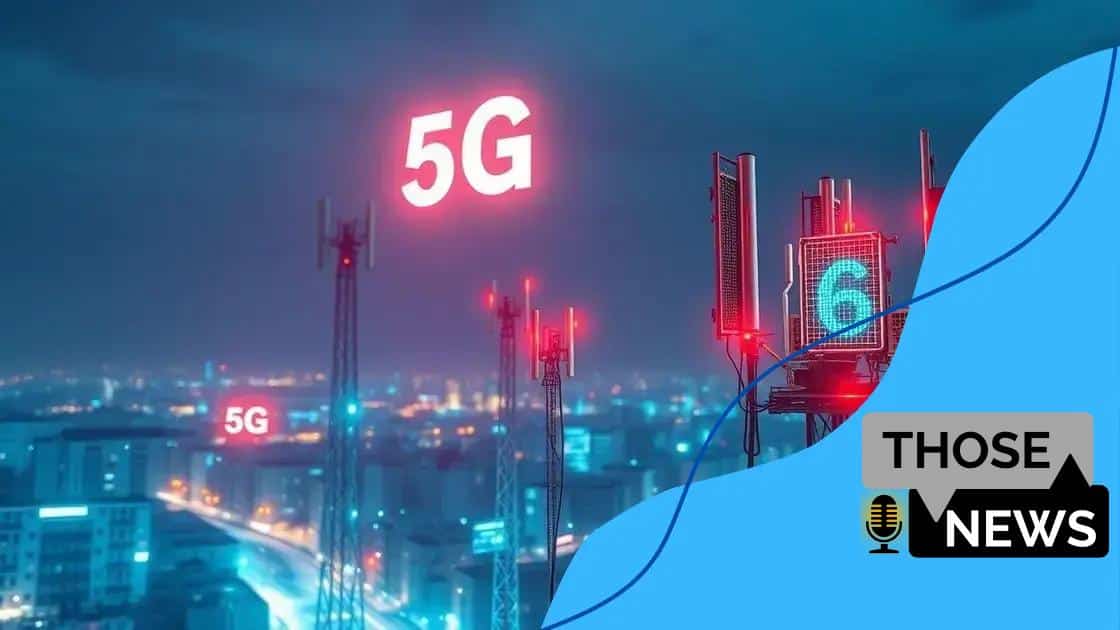5G enhancing telecommunication networks: what’s next?

5G enhancing telecommunication networks significantly improves data speeds, connectivity, and supports innovative applications like IoT, transforming industries such as healthcare and manufacturing while also addressing challenges in infrastructure and regulation.
5G enhancing telecommunication networks is forging a new path in connectivity. Have you ever wondered how this technology will change your daily life and work? Let’s dive into its exciting potential.
Understanding 5G technology basics
Understanding 5G technology is crucial as it changes how we communicate and interact with the world. This new generation of mobile networks promises faster speeds, lower latency, and greater connectivity.
At its core, 5G isn’t just about speed; it’s also about reliability and efficiency. One major aspect of 5G is its ability to connect a vast number of devices with minimal delays. This leads to exciting applications in various fields.
The key features of 5G technology:
5G networks bring several advantages that significantly enhance telecommunication:
- Faster data speeds: Users can download and upload content at lightning speed, making streaming and large file transfers seamless.
- Lower latency: The responsiveness of applications improves, allowing for real-time communication in activities like gaming or video calls.
- Wider coverage: 5G networks can be deployed more broadly, improving connectivity in rural and underserved areas.
- Support for IoT: 5G can connect millions of devices simultaneously, which is essential for the growth of the Internet of Things.
Moreover, 5G technology is designed to evolve continually. Future enhancements could introduce even more remarkable features. As this technology develops, users can look forward to enhanced connectivity in different aspects of daily life, such as smart homes and autonomous vehicles.
In summary, understanding the basics of 5G technology is essential, as it plays a pivotal role in shaping the future of telecommunication networks. The opportunities arising from 5G could redefine how we interact with technology and each other.
Key benefits of 5G in telecommunications
Exploring the key benefits of 5G in telecommunications reveals how this groundbreaking technology transforms the way we connect. 5G is not only faster but also significantly improves user experiences across various platforms.
One of the most notable advantages is the increased data transfer speeds. With 5G, users can enjoy downloads in seconds and seamless streaming. This enhancement is vital as our dependence on data-rich applications grows.
Benefits of 5G technology:
Here are some of the primary benefits that 5G offers to telecommunications:
- Enhanced connectivity: With more reliable connections, 5G can support a greater number of devices without compromising performance.
- Lower latency: The minimal delay allows for real-time communications, which is crucial for applications like remote surgeries and autonomous vehicles.
- Increased capacity: 5G networks can accommodate more data traffic, making them ideal for densely populated areas.
- Cost efficiency: As network infrastructure improves, operational costs can decrease, leading to better pricing for consumers.
Additionally, 5G opens doors to innovative technologies like augmented reality and virtual reality, enhancing entertainment and remote work experiences. The ability to connect multiple devices reliably gives rise to smart cities and the Internet of Things.
The flexibility of 5G networks allows businesses to thrive. Companies can enhance their operations and connect with customers more effectively. In this era of digital transformation, businesses leveraging 5G technology gain a competitive edge.
Challenges in implementing 5G networks

Implementing 5G networks comes with several challenges that need to be addressed for successful deployment. Understanding these obstacles is vital for businesses and service providers in navigating this new technological landscape.
One of the primary challenges is the need for extensive infrastructure changes. Unlike previous generations, 5G requires many small cell towers to ensure consistent coverage. This need can complicate urban planning and raise costs for municipalities.
Key challenges of 5G implementation:
Some of the main challenges that arise when implementing 5G technology include:
- Infrastructure investments: Significant financial resources are necessary to deploy and upgrade existing networks, which can deter smaller providers.
- Regulatory hurdles: Navigating government regulations and obtaining necessary permits can delay the rollout of new 5G sites.
- Compatibility issues: Ensuring that current devices and technologies can integrate with new networks poses additional technical challenges.
- Public concerns: There are ongoing debates about the safety of 5G technology, leading to public resistance in some communities.
Moreover, the high frequency of 5G signals means they are easily obstructed by physical structures like buildings. This characteristic makes planning the placement of antennas critical for maintaining robust service. The deployment process must be strategically managed to overcome these physical limitations.
Additionally, companies face competition in their 5G rollout, creating a race to be the first to provide comprehensive coverage. This urgency can lead to shortcuts that might compromise service quality or safety standards. By being aware of these hurdles, businesses can better prepare to implement solid and effective 5G networks.
Real-world applications of 5G technology
The real-world applications of 5G technology are transforming various industries and enhancing everyday experiences. With its advanced capabilities, 5G enables innovations that were previously unimaginable.
One key area of application is in healthcare. For example, remote surgeries can be performed with high precision thanks to the low latency of 5G networks. Surgeons can operate on patients thousands of miles away, using robotic tools controlled in real time. This technology can save lives and improve access to care in remote regions.
Industry applications of 5G:
The following sectors are seeing significant advancements through 5G:
- Smart cities: 5G enables connected devices in urban environments, helping to manage traffic, reduce energy consumption, and enhance public safety.
- Autonomous vehicles: Self-driving cars rely on 5G for real-time data sharing, allowing them to communicate with other vehicles and infrastructure seamlessly.
- Entertainment: Enhanced streaming experiences and virtual reality applications are possible due to the increased bandwidth offered by 5G.
- Manufacturing: In smart factories, 5G connects machines to optimize production processes, increase efficiency, and reduce downtime.
Moreover, in education, 5G is facilitating new, interactive learning experiences. Students can engage in virtual classrooms, where they can explore concepts in a more immersive way. This type of learning is not only effective but also encourages collaboration among peers.
As 5G continues to expand, more applications will emerge, further influencing how we live and work. The potential for innovation is immense, making the adoption of 5G a pivotal step for numerous sectors.
The future of telecommunication with 5G
The future of telecommunication with 5G promises exciting advancements and revolutionary changes. As we move forward, the impact of 5G technology will shape how we communicate, work, and live.
One of the most significant prospects is the expansion of the Internet of Things (IoT). With 5G, millions of devices can connect and communicate seamlessly. This connectivity will allow for smarter homes and cities, improving daily life in countless ways.
Anticipated developments in telecommunication:
Some of the key changes anticipated in the future of telecommunication include:
- Improved network ability: As 5G networks expand, they will enhance capacity and reduce congestion, allowing for uninterrupted streaming and communication.
- Integration of AI: Artificial intelligence will work alongside 5G, optimizing network performance and automating processes, creating smarter and more efficient systems.
- Advancements in virtual and augmented reality: 5G will enable more immersive experiences, transforming entertainment, training, and remote work.
- Enhanced public safety: Emergency services will utilize real-time data sharing to respond more effectively to incidents, improving community safety.
Moreover, industries like agriculture and manufacturing will adopt 5G technologies to improve efficiency. Smart farming techniques will enable remote monitoring of crops and livestock, leading to better resource management.
As 5G evolves, it will present new business models and opportunities. Companies that embrace this technology early on will gain a competitive edge while enhancing customer experiences across various sectors.
Overall, the future of telecommunications with 5G holds immense potential, driving innovation and progress across multiple fields.
In conclusion, the implementation of 5G technology is set to revolutionize telecommunications. With its ability to enhance connectivity, enable exciting new applications, and drive innovation, 5G promises to change the way we interact with technology. As we look ahead, it’s crucial for businesses and individuals to understand its potential and stay informed. By embracing this technology, we can unlock a future filled with incredible possibilities.
FAQ – Frequently Asked Questions about 5G Technology
What are the main benefits of 5G technology?
The main benefits include faster data speeds, reduced latency, improved connectivity for more devices, and the ability to support advanced applications like IoT.
How will 5G impact healthcare?
5G will enhance telemedicine, enabling remote surgeries and real-time patient monitoring, significantly improving healthcare access and efficiency.
What challenges does 5G implementation face?
Challenges include the need for extensive infrastructure upgrades, regulatory hurdles, and public concerns about health and safety.
How can businesses benefit from adopting 5G?
Businesses can leverage 5G for improved operational efficiency, smarter products, better customer experiences, and new business models.





